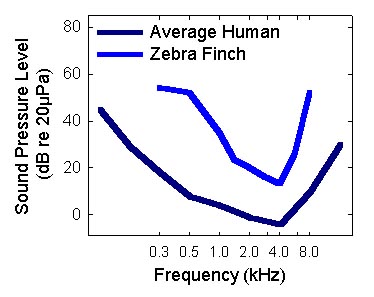| Zebra
Finches
|
|
Zebra finches are domesticated birds native to the semi-arid regions of Australia and nearby islands. They have become popular pets, and are known as the "white rat" of the bird world because of the ease with which they are kept and bred in captivity, making them a favorite model for song studies. Hearing and vocal communication in zebra finches is interesting for several reasons. As in many songbirds, zebra finches learn their songs. Males are also known to learn some characteristics of their distinctive "distance" call. Zebra finch songs and calls, unlike the vocalizations of many other birds, are not whistled or tonal. Rather, they are complex harmonic sounds with a distinctive nasal, rhythmic quality.
Below are sound spectrograms of a male zebra finch song and a female zebra finch "distance" call, as well as a power spectrum of the distance call. Click on the images below to hear these vocalizations.
 The
vocalizations of zebra finches are so different from many other
songbirds, it makes one wonder if their hearing is different also. The
audiogram at left shows the difference between human and zebra finch
hearing thresholds. While the most sensitive hearing thresholds of zebra
finches are still not quite as good as those of humans, recent
experiments have shown that zebra finches are much more sensitive than
humans (and even more sensitive than budgerigars) in discriminating
among complex harmonic sounds such as detecting the mistuning of a
single harmonic in a harmonic complex. The
vocalizations of zebra finches are so different from many other
songbirds, it makes one wonder if their hearing is different also. The
audiogram at left shows the difference between human and zebra finch
hearing thresholds. While the most sensitive hearing thresholds of zebra
finches are still not quite as good as those of humans, recent
experiments have shown that zebra finches are much more sensitive than
humans (and even more sensitive than budgerigars) in discriminating
among complex harmonic sounds such as detecting the mistuning of a
single harmonic in a harmonic complex. |
